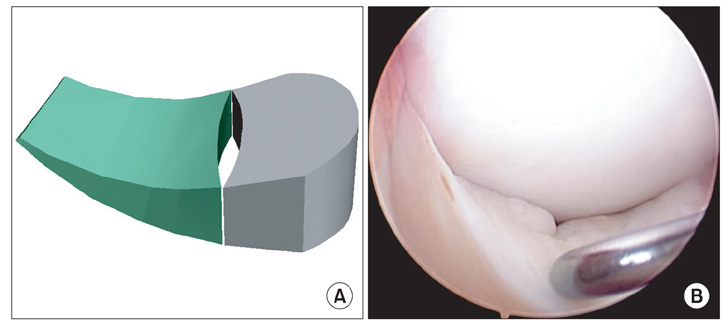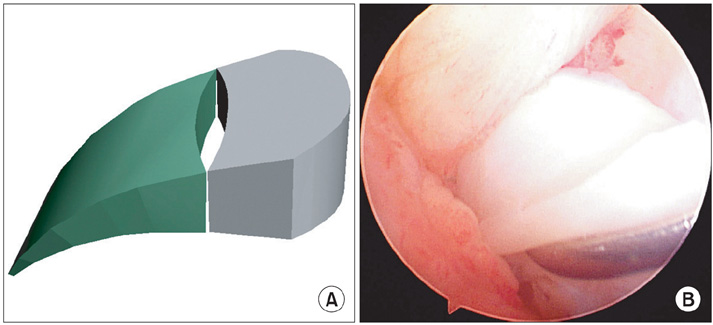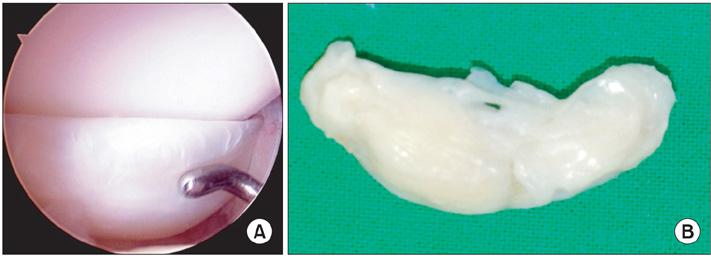Clin Orthop Surg.
2012 Jun;4(2):129-133. 10.4055/cios.2012.4.2.129.
Intra-articular Patterns of Bucket Handle Meniscal Tears and Its Relation to Reducibility
- Affiliations
-
- 1Department of Orthopedic Surgery, Korea University School of Medicine, Seoul, Korea.
- 2Department of Orthopedic Surgery, Seoul Veterans Hospital, Seoul, Korea. zenyjr@yahoo.co.kr
- KMID: 1383874
- DOI: http://doi.org/10.4055/cios.2012.4.2.129
Abstract
- BACKGROUND
The purpose of this study was to assess the intra-articular patterns in the rotational deformities of bucket handle meniscal tears (BHMTs) based on arthroscopic findings and their clinical relevance.
METHODS
From 2004 to 2009, 42 patients with a BHMT diagnosed by magnetic resonance imaging underwent arthroscopic surgery. The arthroscopic data (all procedures were recorded) were evaluated retrospectively, and BHMTs were classified according to the rotational directions of centrally displaced fragments. To assess the reliability of the agreement in this classification, 2 orthopedic surgeons re-classified BHMTs, 1 week after first trial. Intra- and interobserver reliabilities were assessed using kappa statistics. In addition, we address specific tear patterns, associated anterior cruciate ligament injury, medio-lateral difference, reducibility, chronicity, and reparability.
RESULTS
Most of the tears could be categorized into one of 3 morphologic patterns. Of the tears, 4.8% could not be categorized. BHMTs were classified, based on the rotational directions of centrally displaced fragments, as follows; the upward rotation group (type 1), the downward rotation group (type 2) and the reverse group (type 3). The most common intra-articular pattern was type 1 (29 patients, 69%). The occurrence of the other patterns was: type 2 in 7 patients (16.7%), type 3 in 4 patients (9.5%); we were not able to make a classification of type in 2 patients (4.8%). Intra-observer reliability was 0.86 in terms of kappa statistics, which implies almost perfect agreement. Mean interobserver reliability (0.73) showed substantial agreement. Type 1 and 2 tears were easily reduced, whereas all type 3 tears (4/4) needed additional procedures to achieve reduction.
CONCLUSIONS
Based on arthroscopic findings, we describe a comprehensive BHMT classification scheme that encompasses 95.2% of all tears. Tear type was correlated with reducibility.
MeSH Terms
Figure
Reference
-
1. Dandy DJ. The arthroscopic anatomy of symptomatic meniscal lesions. J Bone Joint Surg Br. 1990. 72(4):628–633.
Article2. Campbell WC, Canale ST, Beaty JH. . Campbell's operative orthopaedics. 2008. 11th ed. Philadelphia: Mosby.3. Feng H, Hong L, Geng XS, Zhang H, Wang XS, Jiang XY. Second-look arthroscopic evaluation of bucket-handle meniscus tear repairs with anterior cruciate ligament reconstruction: 67 consecutive cases. Arthroscopy. 2008. 24(12):1358–1366.
Article4. Landis JR, Koch GG. The measurement of observer agreement for categorical data. Biometrics. 1977. 33(1):159–174.
Article5. Yoon JR, Muzaffar N, Kang JW, Lim HC, Bae JH, Nha KW. A novel technique for arthroscopic reduction and repair of a bucket-handle meniscal tear. Knee Surg Sports Traumatol Arthrosc. 2009. 17(11):1332–1335.
Article6. Cargill AO, Jackson JP. Bucket-handle tear of the medial meniscus: a case for conservative surgery. J Bone Joint Surg Am. 1976. 58(2):248–251.
Article7. Bender B, Shabat S, Mann G, Oz H, Adar E. The double-loop technique for meniscal suture. Arthroscopy. 2002. 18(8):944–947.
Article8. Miura H, Kawamura H, Arima J, et al. A new, all-inside technique for meniscus repair. Arthroscopy. 1999. 15(4):453–455.
Article9. Rodeo SA. Arthroscopic meniscal repair with use of the outside-in technique. Instr Course Lect. 2000. 49:195–206.
Article10. Shakespeare DT, Rigby HS. The bucket-handle tear of the meniscus: a clinical and arthrographic study. J Bone Joint Surg Br. 1983. 65(4):383–387.
Article
- Full Text Links
- Actions
-
Cited
- CITED
-
- Close
- Share
- Similar articles
-
- Ananalysis of the Clinical and MRI Findings of the Bucket: Handle Meniscal Tears of the Knee Joint
- Arthroscopic Meniscectomy in Bucket Handle Tear of the Meniscus
- The Displaced Bucket-Handle Tear of the Meniscus: MRi Findings
- The Clinical Study of Meniscal Repair
- Spontaneous Healing of a Displaced Bucket-Handle Tear of the Lateral Meniscus in a Child





